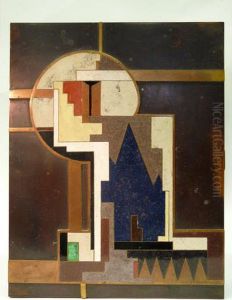Jean Goulden Paintings
Jean Goulden was a notable figure in the decorative arts scene of the early 20th century, particularly renowned for his contributions to the Art Deco movement. Born in 1878 in Angoulême, France, Goulden was originally trained as a physician, having studied medicine in Bordeaux. However, his true passion lay in the realm of art and craftsmanship, which led him to pivot his career away from medicine and towards the decorative arts. His background in science, especially in chemistry, profoundly influenced his artistic endeavors, enabling him to experiment with various materials and techniques that were innovative for his time.
Goulden's most significant contributions were in the field of enameling, where he excelled in the champlevé technique, a method that involves creating cells or recesses in metal objects and filling them with vitreous enamel. He was deeply inspired by Byzantine and medieval enamel work, yet his creations were distinctly modern, characterized by geometric patterns and bold colors that resonated with the Art Deco aesthetic. Goulden was a meticulous craftsman, blending traditional techniques with contemporary designs, and his work often featured a harmonious marriage of gold, silver, and precious stones with the vibrant enamel that became his signature.
During the 1920s and 1930s, Jean Goulden's work gained considerable acclaim, and he became associated with other leading figures of the Art Deco movement, including Jean Dunand, with whom he shared a deep friendship and mutual respect. Despite his success, Goulden remained a relatively private figure, focusing on his craft rather than seeking the spotlight. His pieces were highly sought after by collectors and were featured in prestigious exhibitions, including the 1925 Exposition Internationale des Arts Décoratifs et Industriels Modernes in Paris, which gave the Art Deco movement its name.
Jean Goulden's legacy is that of an innovator who bridged the gap between art and science, bringing a level of precision and creativity to the decorative arts that was unparalleled. His work is celebrated for its technical mastery and aesthetic beauty, and it continues to be admired by collectors and scholars alike. Goulden died in 1946, leaving behind a body of work that remains influential in the fields of enameling and decorative arts. His contributions to the Art Deco movement have cemented his place as one of the era's most important and innovative artists.







